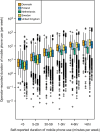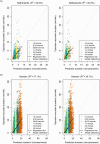Regression calibration of self-reported mobile phone use to optimize quantitative risk estimation in the COSMOS study
- PMID: 38751312
- PMCID: PMC11458186
- DOI: 10.1093/aje/kwae039
Regression calibration of self-reported mobile phone use to optimize quantitative risk estimation in the COSMOS study
Abstract
The Cohort Study of Mobile Phone Use and Health (COSMOS) has repeatedly collected self-reported and operator-recorded data on mobile phone use. Assessing health effects using self-reported information is prone to measurement error, but operator data were available prospectively for only part of the study population and did not cover past mobile phone use. To optimize the available data and reduce bias, we evaluated different statistical approaches for constructing mobile phone exposure histories within COSMOS. We evaluated and compared the performance of 4 regression calibration (RC) methods (simple, direct, inverse, and generalized additive model for location, shape, and scale), complete-case analysis, and multiple imputation in a simulation study with a binary health outcome. We used self-reported and operator-recorded mobile phone call data collected at baseline (2007-2012) from participants in Denmark, Finland, the Netherlands, Sweden, and the United Kingdom. Parameter estimates obtained using simple, direct, and inverse RC methods were associated with less bias and lower mean squared error than those obtained with complete-case analysis or multiple imputation. We showed that RC methods resulted in more accurate estimation of the relationship between mobile phone use and health outcomes by combining self-reported data with objective operator-recorded data available for a subset of participants.
Keywords: cohort analysis; exposure assessment; health outcomes; measurement error; mobile phone use; regression calibration.
© The Author(s) 2024. Published by Oxford University Press on behalf of the Johns Hopkins Bloomberg School of Public Health.
Conflict of interest statement
M.F. was vice chairman (2012-2020) of the International Commission on Non-Ionizing Radiation Protection, an independent body setting guidelines for non-ionizing radiation protection. She has served as advisor to a number of national and international public advisory and research steering groups concerning the potential health effects of exposure to non-ionizing radiation, currently for the World Health Organization (WHO). H.K. was the chair of the Committee on Electromagnetic Fields of the Health Council of The Netherlands till 2022. He currently is a member of the WHO Task Group for the Environmental Health Criteria Monograph on RF-EMF. A.H. is a member of the International Commission on Non-Ionizing Radiation Protection since 2020, and of the Committee on Electromagnetic Fields of the Health Council of The Netherlands, and chairs the Swedish Radiation Safety Authority’s (SSM) Scientific Council on Electromagnetic Fields since 2020. A.A. currently is a member of the WHO Task Group for the Environmental Health Criteria Monograph on RF-EMF. M.B.T. is currently a member of the WHO groups tasked with systematic review of evidence on non-ionizing radiation and health, feeding into the Environmental Health Criteria Monograph on RF-EMF. All other authors declare they have no competing financial interests.
Figures





Similar articles
-
An international prospective cohort study of mobile phone users and health (COSMOS): Factors affecting validity of self-reported mobile phone use.Int J Hyg Environ Health. 2018 Jan;221(1):1-8. doi: 10.1016/j.ijheh.2017.09.008. Epub 2017 Sep 20. Int J Hyg Environ Health. 2018. PMID: 29056311
-
Mobile phone use and brain tumour risk - COSMOS, a prospective cohort study.Environ Int. 2024 Mar;185:108552. doi: 10.1016/j.envint.2024.108552. Epub 2024 Mar 2. Environ Int. 2024. PMID: 38458118
-
Validation of exposure assessment and assessment of recruitment methods for a prospective cohort study of mobile phone users (COSMOS) in Finland: a pilot study.Environ Health. 2011 Mar 8;10:14. doi: 10.1186/1476-069X-10-14. Environ Health. 2011. PMID: 21385407 Free PMC article.
-
The effect of exposure to radiofrequency fields on cancer risk in the general and working population: A systematic review of human observational studies - Part II: Less researched outcomes.Environ Int. 2025 Feb;196:109274. doi: 10.1016/j.envint.2025.109274. Epub 2025 Jan 11. Environ Int. 2025. PMID: 39904670
-
The effect of exposure to radiofrequency fields on cancer risk in the general and working population: A systematic review of human observational studies - Part I: Most researched outcomes.Environ Int. 2024 Sep;191:108983. doi: 10.1016/j.envint.2024.108983. Epub 2024 Aug 30. Environ Int. 2024. PMID: 39241333
Cited by
-
Use of Mobile Phones and Radiofrequency-Emitting Devices in the COSMOS-France Cohort.Int J Environ Res Public Health. 2024 Nov 14;21(11):1514. doi: 10.3390/ijerph21111514. Int J Environ Res Public Health. 2024. PMID: 39595781 Free PMC article.
-
Detailed assessment of night shift work aspects and potential mediators of its health effects: the contribution of field studies.Front Public Health. 2025 May 22;13:1578128. doi: 10.3389/fpubh.2025.1578128. eCollection 2025. Front Public Health. 2025. PMID: 40475203 Free PMC article.
References
-
- Carroll RJ, Ruppert D, Stefanski LA, et al.. Measurement error in nonlinear models: a modern perspective. Chapman & Hall/CRC. 2006;39(2):231–232. 10.1080/00401706.1997.10485096 - DOI
-
- Freedman LS, Commins JM, Willett W, et al.. Practice of epidemiology evaluation of the 24-hour recall as a reference instrument for calibrating other self-report instruments in nutritional cohort studies: evidence from the Validation Studies Pooling Project. Am J Epidemiol. 2018;186(1):73–82. 10.1093/aje/kwx039 - DOI - PMC - PubMed
MeSH terms
Grants and funding
- UKDRI-5001/UK Medical Research Council, Alzheimer's Society and Alzheimer's Research UK
- NIHR-200922/NIHR Imperial Biomedical Research Centre, the NIHR Health Protection Research Unit in Chemical and Radiation Threats and Hazards
- 85800001/the Netherlands Organization for Health Research (ZonMW)
- MR/S019669/1/MRC_/Medical Research Council/United Kingdom
- 001/WHO_/World Health Organization/International
LinkOut - more resources
Full Text Sources
Miscellaneous

